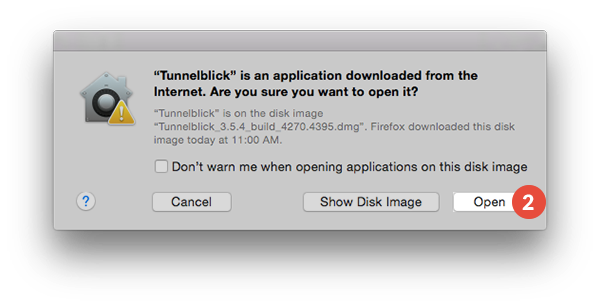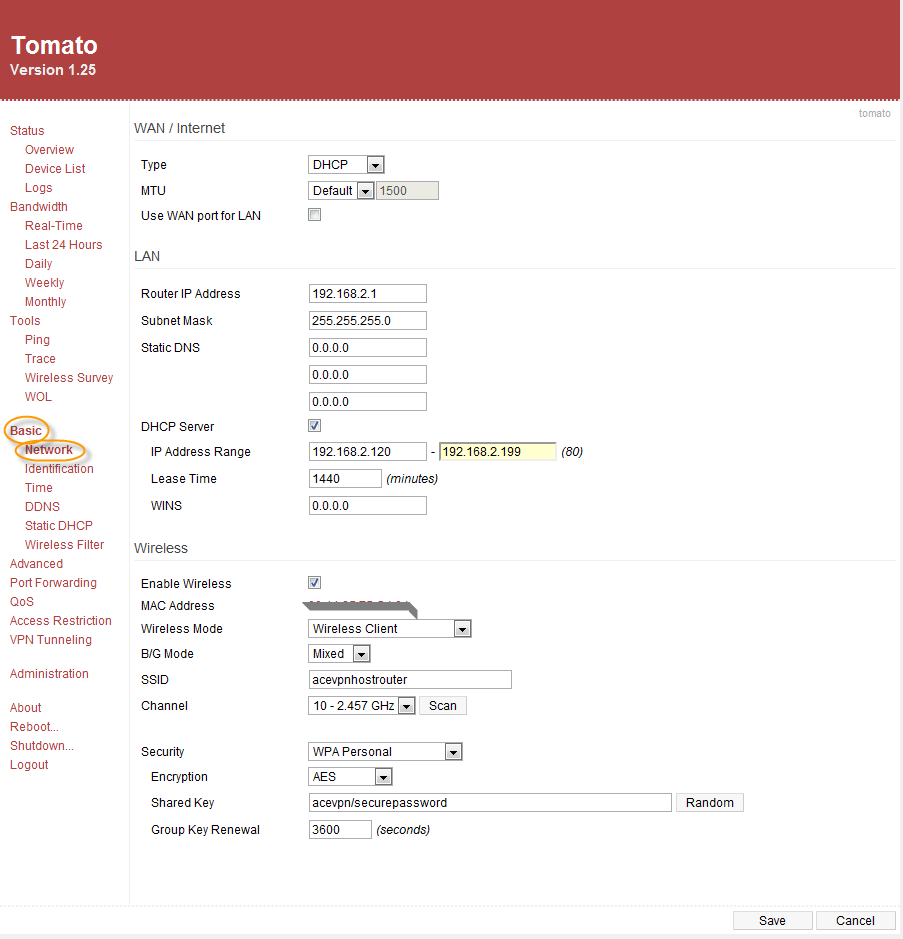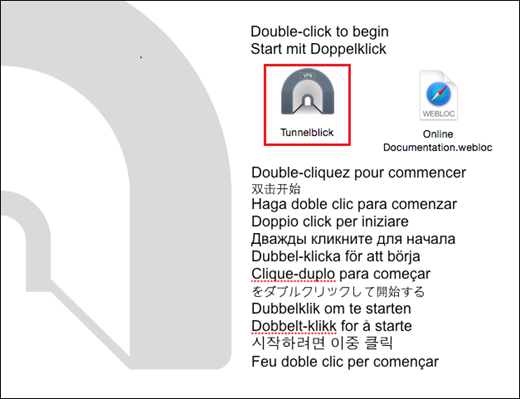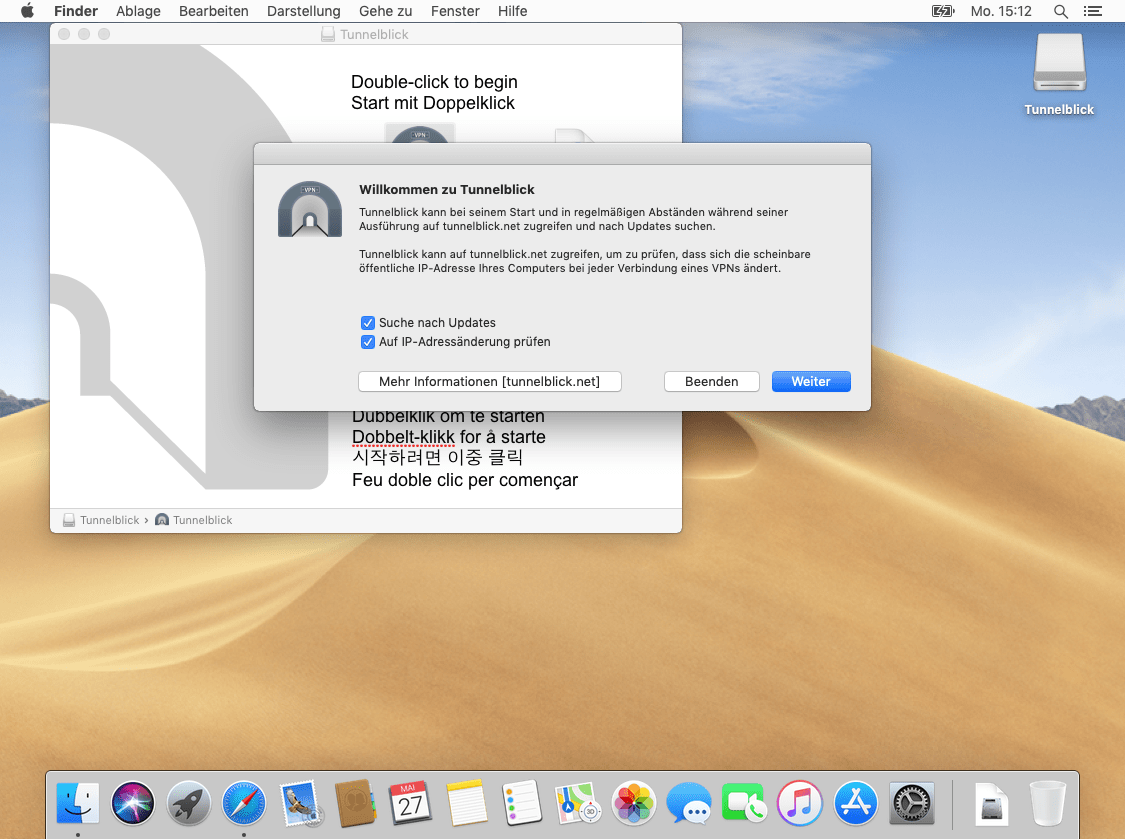Tunnelblick's official website is at Tunnelblick is a free, open source graphic user interface for OpenVPN on Mac OS X. It provides easy control of OpenVPN client and/or server connections. It comes as a ready-to-use application with all necessary binaries and drivers (including OpenVPN and tun/tap drivers). If you want to use IPv6, open the Tunnelblick settings. To do this, click on the Tunnelblick icon in the icon bar at the top right and click on the VPN Details. In this window, select the currently imported profile on the left, switch to the Settings tab and uncheck Disable IPv6 unless the VPN server is accessed using IPv6.


Please Note: This guide assumes that you are using Safari and have 'Allow files to Open/Execute (aka Safe Files) upon download completion' enabled. If you are not, you may have issues with Step 9 ongoing.
- Download the Latest TunnelBlick install from https://tunnelblick.net/downloads.html
- Double Click the Tunnelblick dmg from your downloads folder to mount the image
- Double Click on the Tunnelblick icon to install.
- If you get a notice that 'Tunnelblick is an Application downloaded from the Internet' Click Open to confirm that you want to Open it.
- Type your computer Admin password to allow the Install.
- Click Launch
- Click I Have Configuration Files
- Download the Configuration Files https://www.privateinternetaccess.com/openvpn/openvpn.zip
- Rename this downloaded file as openvpn.tblk and on the window that appears, choose 'Add' to accept the file extension change. Double click openvpn.tblk, and allow the option to apply installation of multiple files.
- Tunnelblick will ask if you want to add for All users, or just your user.
- Enter your computer Admin password to allow the configuration file to be added.
- Click the Tunnelblick icon in the Menu bar to connect
- Enter your Username and password when prompted.
EASY Setup Guides for Alternate Configurations (Advanced):
Tunnelblick Openvpn Mac Download
If you need encryption, please use the Private Internet Application or OpenVPN protocol with our service.
- OpenVPN Configuration Files (Recommended Default)
OpenVPN Configuration Files (Recommended Default windows only plus block-outside-dns)
OpenVPN Configuration Files (Strong)


Legacy
- Although quite different from a VPN, we provide a SOCKS5 Proxy with all accounts in the event users require this feature.
SOCKS5 Proxy Usage Guides
proxy-nl.privateinternetaccess.com port 1080
- Enable port forwarding in the application by entering the Advanced area, enabling port forwarding and selecting one of the following gateways:
After enabling port forwarding and re-connecting to one of the above gateways, please hover your mouse over the System Tray or Menu Bar icon to reveal the tooltip which will display the port number. You can then enter this port into your software.
Port Forwarding reduces privacy. For maximum privacy, please keep port forwarding disabled.
- IPv6 leak protection disables IPv6 traffic while on the VPN. This ensures that no IPv6 traffic leaks out over your normal internet connection when you are connected to the VPN. This includes 6to4 and Teredo tunneled IPv6 traffic.
- The dns leak protection feature activates VPN dns leak protection. This ensures that DNS requests are routed through the VPN. This enables the greatest level of privacy and security but may cause connectivity issues in non-standard network configurations.
This can be enabled and disabled in the Windows application, while it is enabled by default on our macOS application.
We use our own private DNS servers for your DNS queries while on the VPN. After connecting we set your operating system's DNS servers to 209.222.18.222 and 209.222.18.218. When using a DNS Leak testing site you should expect to see your DNS requests originate from the IP of the VPN gateway you are connected to.
If you change your DNS servers manually or if for some other reason they are changed this does not necessarily mean your DNS is leaking. Even if you use different DNS servers the queries will still be routed through the VPN connection and will be anonymous.
- The internet kill switch activates VPN disconnect protection. If you disconnect from the VPN, your internet access will stop working. It will reactivate normal internet access when you deactivate the kill switch mode or exit the application.
Users who may be connected to two connections simultaneously (ex.: wired and wireless) should not use this feature, as it will only stop 1 active connection type.

Please Note: This guide assumes that you are using Safari and have 'Allow files to Open/Execute (aka Safe Files) upon download completion' enabled. If you are not, you may have issues with Step 9 ongoing.
- Download the Latest TunnelBlick install from https://tunnelblick.net/downloads.html
- Double Click the Tunnelblick dmg from your downloads folder to mount the image
- Double Click on the Tunnelblick icon to install.
- If you get a notice that 'Tunnelblick is an Application downloaded from the Internet' Click Open to confirm that you want to Open it.
- Type your computer Admin password to allow the Install.
- Click Launch
- Click I Have Configuration Files
- Download the Configuration Files https://www.privateinternetaccess.com/openvpn/openvpn.zip
- Rename this downloaded file as openvpn.tblk and on the window that appears, choose 'Add' to accept the file extension change. Double click openvpn.tblk, and allow the option to apply installation of multiple files.
- Tunnelblick will ask if you want to add for All users, or just your user.
- Enter your computer Admin password to allow the configuration file to be added.
- Click the Tunnelblick icon in the Menu bar to connect
- Enter your Username and password when prompted.
EASY Setup Guides for Alternate Configurations (Advanced):
Tunnelblick Openvpn Mac Download
If you need encryption, please use the Private Internet Application or OpenVPN protocol with our service.
- OpenVPN Configuration Files (Recommended Default)
OpenVPN Configuration Files (Recommended Default windows only plus block-outside-dns)
OpenVPN Configuration Files (Strong)
Legacy
- Although quite different from a VPN, we provide a SOCKS5 Proxy with all accounts in the event users require this feature.
SOCKS5 Proxy Usage Guides
proxy-nl.privateinternetaccess.com port 1080
- Enable port forwarding in the application by entering the Advanced area, enabling port forwarding and selecting one of the following gateways:
After enabling port forwarding and re-connecting to one of the above gateways, please hover your mouse over the System Tray or Menu Bar icon to reveal the tooltip which will display the port number. You can then enter this port into your software.
Port Forwarding reduces privacy. For maximum privacy, please keep port forwarding disabled.
- IPv6 leak protection disables IPv6 traffic while on the VPN. This ensures that no IPv6 traffic leaks out over your normal internet connection when you are connected to the VPN. This includes 6to4 and Teredo tunneled IPv6 traffic.
- The dns leak protection feature activates VPN dns leak protection. This ensures that DNS requests are routed through the VPN. This enables the greatest level of privacy and security but may cause connectivity issues in non-standard network configurations.
This can be enabled and disabled in the Windows application, while it is enabled by default on our macOS application.
We use our own private DNS servers for your DNS queries while on the VPN. After connecting we set your operating system's DNS servers to 209.222.18.222 and 209.222.18.218. When using a DNS Leak testing site you should expect to see your DNS requests originate from the IP of the VPN gateway you are connected to.
If you change your DNS servers manually or if for some other reason they are changed this does not necessarily mean your DNS is leaking. Even if you use different DNS servers the queries will still be routed through the VPN connection and will be anonymous.
- The internet kill switch activates VPN disconnect protection. If you disconnect from the VPN, your internet access will stop working. It will reactivate normal internet access when you deactivate the kill switch mode or exit the application.
Users who may be connected to two connections simultaneously (ex.: wired and wireless) should not use this feature, as it will only stop 1 active connection type.
Tunnelblick For Ipad
Highlighted Articles Discussion Group | On This Page The Tunnelblick ApplicationThe Tunnelblick application, Tunnelblick.app, must be stored directly in /Applications on the startup volume for security reasons. Thus it cannot be used from network drives or internal or external drives including thumb or flash drives, CD/DVD drives, etc. unless they are being used as the startup volume. Running Tunnelblick from from anywhere except /Applications on the startup volume will result in an offer to install Tunnelblick in /Applications on the startup volume. OpenVPN, Drivers, and Standard ScriptsThe OpenVPN program, openvpn-down-root.so, the Tun and Tap system extension files, and standard client up/down scripts are included with, and contained within, Tunnelblick.app. Log FilesLog files are stored in /Library/Application Support/Tunnelblick/Logs. (Early versions of Tunnelblick stored them in /tmp/tunnelblick). The log files for a configuration are created or deleted and recreated each time the connection is made. There are two log files for each configuration, an OpenVPN log file and a scripts log file. The contents of the files are merged in the display in Tunnelblick's 'VPN Details' window. Key and Certificate FilesThese may be stored anywhere, but typically they are stored in the same folder as the configuration (.ovpn or .conf) file. Key and certificate files associated with a Tunnelblick VPN Configuration (.tblk) are stored inside the configuration itself. Key and certificate files usually have an extension of .cer, .crt, .der, .key, .p12, .p7b, .p7c, .pem, or .pfx. Configuration FilesThere are two types of configuration files:
Note: Configurations should always be installed by dropping them on the Tunnelblick icon in the menu bar. If you just move or copy them they may not work properly. There are five places configuration files may be stored:
Note: Prior to Tunnelblick version 3.0b24, private configuration files were stored in ~/Library/openvpn. Version 3.0b24 and later versions automatically move that folder to its new location, and replace it with a symbolic link to the new location. Custom ScriptsThere are two types of custom scripts that can be run at certain points in the connect/disconnect process:
These scripts should be located in a Tunnelblick VPN Configurations without any folder structure, and references to them should not contain any path information. For more information, see Using Scripts. LaunchDaemonsDurring installation, Tunnelblick sets up a 'daemon' to perform privileged operations such as starting OpenVPN as root. The daemon has a .plist file named net.tunnelblick.tunnelblick.tunnelblickd.plist in /Library/LaunchDaemons. If a configuration is set to connect when the computer starts, it has a .plist file located in /Library/LaunchDaemons. These .plist files are all named starting with 'net.tunnelblick.startup.' PreferencesA user's Tunnelblick preferences are contained in Note: In Tunnelblick 3.2beta10 and earlier, preferences are stored in Deployed versions of Tunnelblick may contain a 'forced-preferences.plist' file within the Tunnelblick application itself. They are used to override the user's normal preferences; see Deploying Tunnelblick for details. Tunnelblick VPN Configurations may also include preference defaults, which are used to initialize the user's preferences (which may then be changed by the user). One More ThingUnder certain circumstances, Tunnelblick replaces the configuration folder that very old versions of Tunnelblick use, |
